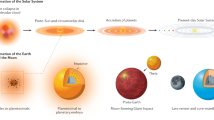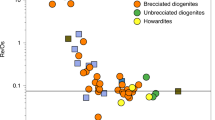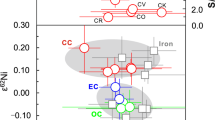Abstract
Earth, Venus, Mars and asteroids such as Vesta and, perhaps, Lutetia1 have chondritic bulk compositions with massive silicate mantles surrounding iron cores. Anomalies include Mercury with its abundant metallic iron (about 70% by mass2), the Moon with its small iron core, and metal-dominated asteroids. Although a giant impact with proto-Earth can explain the Moon’s small core3, a giant impact origin for Mercury is problematic. Such a scenario requires that proto-Mercury was blasted apart with far greater specific energy than required for lunar formation4, yet retained substantial volatile elements5 and did not reaccrete its ejected mantle6. Here we present numerical hydrocode simulations showing that proto-Mercury could have been stripped of its mantle in one or more high-speed collisions with a larger target planet that survived intact. A projectile that escapes the planet-colliding orbit in this hit-and-run scenario7 ultimately finds a permanent sink for its stripped mantle silicates. We show that if Mars and Mercury are derived from two planetary embryos that randomly avoided being accreted into a larger body, out of 20 original embryos (the rest having accreted into Venus and Earth), then it is statistically probable that one of those had its mantle stripped in one or two hit-and-run collisions. The same reasoning applies to pairwise accretion of planetesimals in the early Solar System, in which the relic bodies, which avoided becoming accreted, would be expected to have a wide diversity of compositions as a consequence of hit-and-run processes.
This is a preview of subscription content, access via your institution
Access options
Subscribe to this journal
Receive 12 print issues and online access
$259.00 per year
only $21.58 per issue
Buy this article
- Purchase on Springer Link
- Instant access to full article PDF
Prices may be subject to local taxes which are calculated during checkout




Similar content being viewed by others
References
Elkins-Tanton, L. T., Weiss, B. P. & Zuber, M. T. Chondrites as samples of differentiated planetesimals. Earth Planet. Sci. Lett. 305, 1–10 (2011).
Hauck, S. A. et al. The curious case of Mercury’s internal structure. J. Geophys. Res. 118, 1204–1220 (2013).
Asphaug, E. Impact origin of the moon? Annu. Rev. Earth Planet. Sci. 42, 551–578 (2014).
Benz, W., Anic, A., Horner, J. & Whitby, J. A. The origin of Mercury. Space Sci. Rev. 132, 189–202 (2007).
Peplowski, P. N. et al. Radioactive elements on Mercury’s surface from MESSENGER: Implications for the planet’s formation and evolution. Science 333, 1850–1852 (2011).
Gladman, B. & Coffey, J. Mercurian impact ejecta: Meteorites and mantle. Meteorit. Planet. Sci. 44, 285–291 (2009).
Asphaug, E., Agnor, C. B. & Williams, Q. Hit-and-run planetary collisions. Nature 439, 155–160 (2006).
Morbidelli, A., Bottke, W. F., Nesvorný, D. & Levison, H. F. Asteroids were born big. Icarus 204, 558–573 (2009).
Kleine, T., Mezger, K., Palme, H., Scherer, E. & Münker, C. Early core formation in asteroids and late accretion of chondrite parent bodies: Evidence from 182Hf–182W in CAIs, metal-rich chondrites, and iron meteorites. Geochim. Cosmochim. Acta 69, 5805–5818 (2005).
Safronov, V. S. Evolution of the Protoplanetary Cloud and Formation of the Earth and Planets (NASA Tech. Transl. F-677, 1972).
Agnor, C. & Asphaug, E. Accretion efficiency during planetary collisions. Astrophys. J. 613, L157–L160 (2004).
Asphaug, E. Similar-sized collisions and the diversity of planets. Chem. Erde Geochem. 70, 199–219 (2010).
Stewart, S. T. & Leinhardt, Z. M. Collisions between gravity-dominated bodies. II. The diversity of impact outcomes during the end stage of planet formation. Astrophys. J. 751, 32–49 (2012).
Reufer, A. Collisions in Planetary Systems. PhD thesis, Univ. of Bern (2011)
Asphaug, E. & Reufer, A. Late origin of the Saturn system. Icarus 223, 544–565 (2013).
Canup, R. M. Dynamics of lunar formation. Annu. Rev. Astron. Astrophys. 42, 441–475 (2004).
Reufer, A., Meier, M. M. M., Benz, W. & Wieler, R. A hit-and-run giant impact scenario. Icarus 221, 296–299 (2012).
Benz, W., Slattery, W. L. & Cameron, A. G. W. Collisional stripping of Mercury’s mantle. Icarus 74, 516–528 (1988).
O’Brien, D. P., Morbidelli, A. & Levison, H. F. Terrestrial planet formation with strong dynamical friction. Icarus 184, 39–58 (2006).
Stewart, S. T., Leinhardt, Z. M. & Humayun, M. Giant impacts, volatile loss, and the K/Th ratios on the Moon, Earth, and Mercury. 44th Lunar and Planetary Science Conference Abstract 2306 (2013)
Chambers, J. E. Late-stage planetary accretion including hit-and-run collisions and fragmentation. Icarus 224, 43–56 (2013).
Burbine, T. H., Meibom, A. & Binzel, R. P. Mantle material in the main belt: Battered to bits? Meteorit. Planet. Sci. 31, 607–620 (1996).
Farinella, P., Paolicchi, P. & Zappala, V. The asteroids as outcomes of catastrophic collisions. Icarus 52, 409–433 (1982).
Davis, D. R., Chapman, C. R., Weidenschilling, S. J. & Greenberg, R. Collisional history of asteroids—evidence from Vesta and the Hirayama families. Icarus 62, 30–53 (1985).
Yang, J., Goldstein, J. I. & Scott, E. R. D. Iron meteorite evidence for early formation and catastrophic disruption of protoplanets. Nature 446, 888–891 (2007).
Moskovitz, N. A. & Walker, R. J. Size of the group IVA iron meteorite core: Constraints from the age and composition of Muonionalusta. Earth Planet. Sci. Lett. 308, 410–416 (2011).
Asphaug, E., Jutzi, M. & Movshovitz, N. Chondrule formation during planetesimal accretion. Earth Planet. Sci. Lett. 308, 369–379 (2011).
Wetherill, G. W. Formation of the terrestrial planets. Annu. Rev. Astron. Astrophys. 18, 77–113 (1980).
Bottke, W. F., Nesvorný, D., Grimm, R. E., Morbidelli, A. & O’Brien, D. P. Iron meteorites as remnants of planetesimals formed in the terrestrial planet region. Nature 439, 821–824 (2006).
Melosh, H. J. A hydrocode equation of state for SiO2 . Meteorit. Planet. Sci. 42, 2079–2098 (2007).
Acknowledgements
This research is sponsored by NASA NNX13AR66G, Collisional Accretion of Similar-Sized Bodies. Computing resources and travel by A.R. were provided by Arizona State University. We thank M. Kreslavsky (UCSC) for valuable discussions.
Author information
Authors and Affiliations
Contributions
A.R. ran and reduced the suites of SPH simulations. E.A. constructed the statistical analysis and wrote the paper.
Corresponding author
Ethics declarations
Competing interests
The authors declare no competing financial interests.
Rights and permissions
About this article
Cite this article
Asphaug, E., Reufer, A. Mercury and other iron-rich planetary bodies as relics of inefficient accretion. Nature Geosci 7, 564–568 (2014). https://doi.org/10.1038/ngeo2189
Received:
Accepted:
Published:
Issue Date:
DOI: https://doi.org/10.1038/ngeo2189
This article is cited by
-
The Exosphere as a Boundary: Origin and Evolution of Airless Bodies in the Inner Solar System and Beyond Including Planets with Silicate Atmospheres
Space Science Reviews (2022)
-
Terrestrial planet compositions controlled by accretion disk magnetic field
Progress in Earth and Planetary Science (2021)
-
Early terrestrial planet formation by torque-driven convergent migration of planetary embryos
Nature Astronomy (2021)
-
Geodesy, Geophysics and Fundamental Physics Investigations of the BepiColombo Mission
Space Science Reviews (2021)
-
Spitzer’s debris disk legacy from main-sequence stars to white dwarfs
Nature Astronomy (2020)



